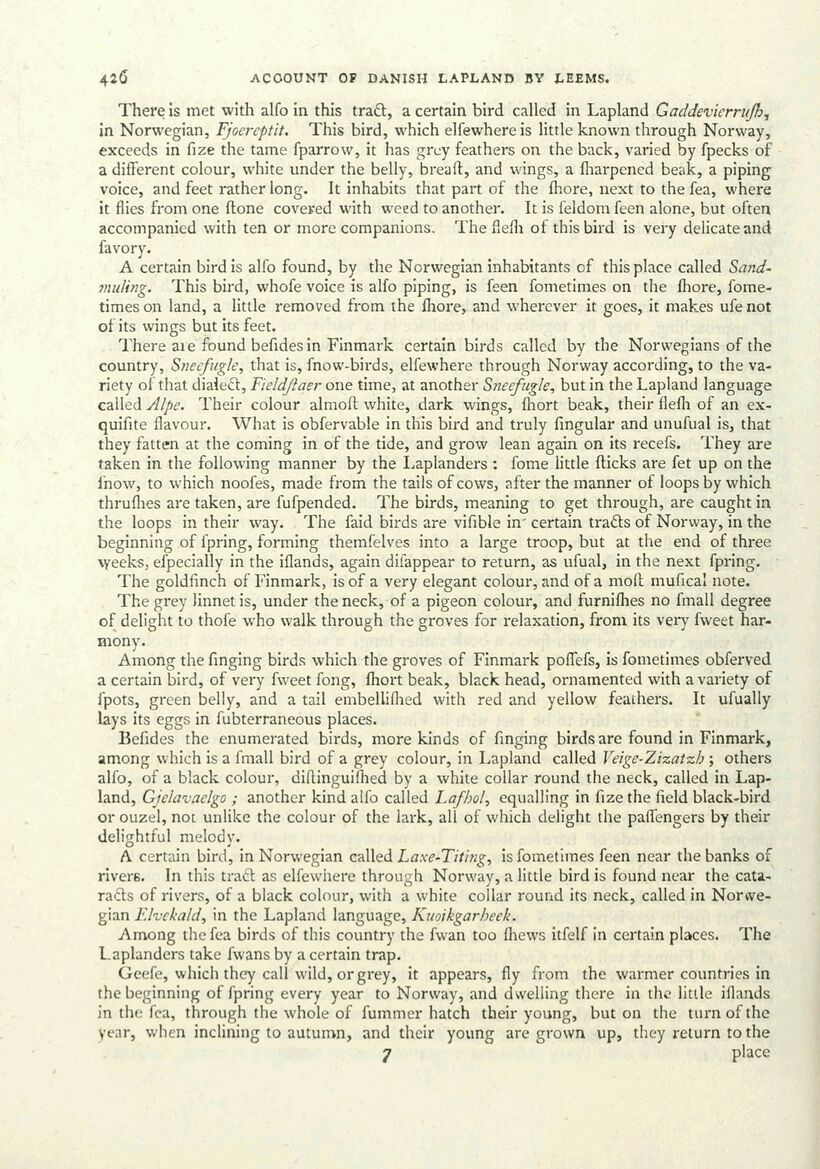
Full resolution (JPEG) - On this page / på denna sida - Pages ...

<< prev. page << föreg. sida << >> nästa sida >> next page >>
Below is the raw OCR text
from the above scanned image.
Do you see an error? Proofread the page now!
Här nedan syns maskintolkade texten från faksimilbilden ovan.
Ser du något fel? Korrekturläs sidan nu!
This page has never been proofread. / Denna sida har aldrig korrekturlästs.
426 ACOOUNT OF DANISH LAPLAND BY LEEMS.
There is met with alfo in this traét, a certain bird called in Lapland Gaddevierrufh,
in Norwegian, Fyoereptit. This bird, which elfewhere is little known through Norway,
exceeds in fize the tame fparrow, it has grcy feathers on the back, varied by fpecks of -
a different colour, white under the belly, breaft, and wings, a fharpened beak, a piping
voice, and feet ratherlong. It inhabits that part of the fhore, next to the fea, where
it flies from one {tone covered with weed toanother. It is feldom feen alone, but often
accompanied with ten or more companions. ‘The flefh of this bird is very delicate and
favory.
A cain birdis alfo found, by the Norwegian inhabitants of this place called Sand-
muling. ‘This bird, whofe voice is alfo piping, is feen fometimes on the fhore, fome-
times on land, a little removed from the fhore, and wherever it goes, it makes ufe not
of its wings but its feet.
There ave found befidesin Finmark certain birds called by the Norwegians of the
country, Snecfugle, that is, fmow-birds, elfewhere through Norway according, to the va-
riety of that dialect, Fie/dfaer one time, at another Sneefugle, but in the Lapland language
called A/pe. Their colour almoft white, dark wings, fhort beak, their flefh of an ex-
quifite flavour. What is obfervable in this bird and truly fingular and unufual is, that
they fatten at the coming in of the tide, and grow lean again on its recefs. ‘They are
taken in the following manner by the Laplanders: fome little {ticks are fet up on the
{now, to which noofes, made from the tails of cows, after the manner of loops by which
thrufhes are taken, are fufpended. The birds, meaning to get through, are caught in
the loops in their way. The {faid birds are vifible in’ certain tracts of Norway, in the
beginning of {pring, forming themfelves into a large troop, but at the end of three
weeks, efpecially in the iflands, again difappear to return, as ufual, in the next {pring.
The goldfinch of Finmark, is of a very elegant colour, and of a moft mufical note.
The grey Jinnet is, under the neck, of a pigeon colour, and furnifhes no {mall degree
of delight to thofe who walk through the groves for relaxation, from its very {weet har-
mony.
Anante the finging birds which the groves of Finmark poffefs, is fometimes obferved
a certain bird, of very fweet fong, fhort beak, black head, ornamented with a variety of
{pots, green belly, and a tail embellifhed with red and yellow feathers. It ufually
lays its eggs in fubterraneous places. ;
Befides the enumerated birds, more kinds of finging birds are found in Finmark,
among which isa fmall bird of a grey colour, in Lapland called Veige-Zizatzh ; others
alfo, of a black colour, diftinguifhed by a white collar round the neck, called in Lap-
land, Gyelavaelgo ; another kind alfo called Lafhol, equalling in fize the field black-bird
or ouzel, not unlike the colour of the lark, all of which delight the paflengers by their
delightful melody.
A certain bird, in Norwegian called Laxe-Titing, is fometimes feen near the banks of
rivers. In this traét as elfewhere through Norway, a little bird is found near the cata-
racts of rivers, of a black colour, with a white collar round its neck, called in Norwe-
gian E/vekald, in the Lapland language, Kuoikgarheek.
Among the fea birds of this country the fwan too fhews itfelf in certain places. The
Laplanders take fwans by a certain trap.
Geefe, which they call wild, or grey, it appears, fly from the warmer countries in
the beginning of fpring every year to Norway, and dwelling there in the little iflands
in the fea, through the whole of fummer hatch their young, but on the turn of the
year, when inclining to autumn, and their young are grown up, they return tothe
7 place
<< prev. page << föreg. sida << >> nästa sida >> next page >>